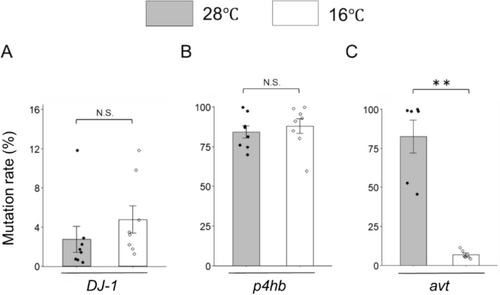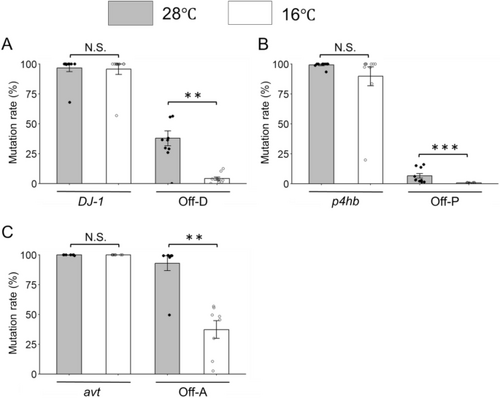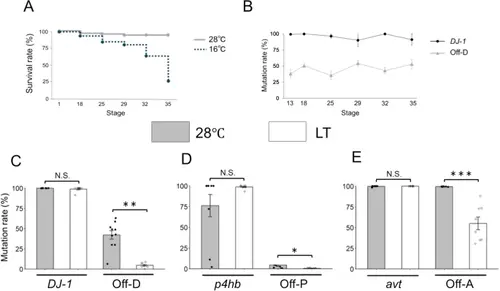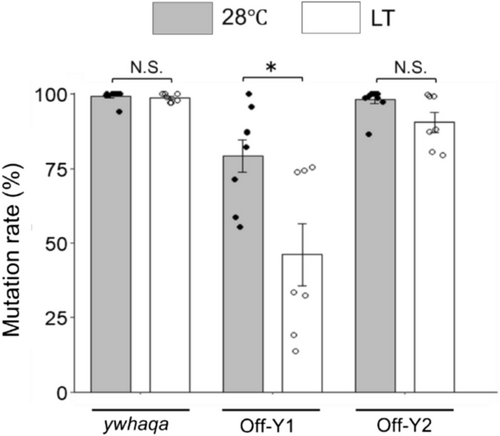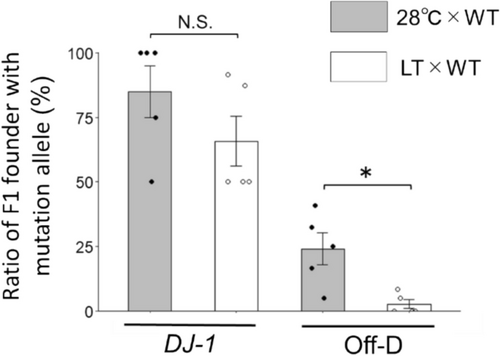- Title
-
Low-temperature embryo incubation suppresses off-target mutagenesis during CRISPR-Cas9 genome editing in medaka (Oryzias latipes) and zebrafish (Danio rerio)
- Authors
- Yamanaka, T., Sogo, A., Maegawa, S., Kinoshita, M.
- Source
- Full text @ Transgenic. Res.
|
The effect of low-temperature incubation on the on-target mutation rate. After the introduction of RGEN, embryos were cultured at 28 °C or 16 °C until Stage 25. Amplicon sequencing was performed for each region, and the mutation rate was calculated. A DJ-1 (n = 8) B p4hb (n = 8) C avt (n = 6). While no significant difference in mutation rate was observed between temperatures for DJ-1 and p4hb, the mutation rate for avt was significantly reduced at 16 °C compared to 28 °C. N.S.: no significant difference, **: p < 0.01, Columns and error bars represent mean ± SE |
|
The effect of low-temperature incubation on on-target and off-target mutation rates. After the introduction of RGEN, embryos were cultured at 28 °C or 16 °C until Stage 25. Amplicon sequencing was performed for each region, and the mutation rate was calculated. A DJ-1 and Off-D (n = 10) B p4hb and Off-P (n = 10) C avt and Off-A (n = 8). While no significant difference in on-target mutation rates was observed between temperatures, off-target mutation rates were significantly reduced at 16 °C compared to 28 °C. N.S.: no significant difference, **: p < 0.01, ***: p < 0.001 Columns and error bars represent mean ± SE |
|
Low-temperature treatment (LT) during the early stages of embryonic development reduces off-target mutagenesis without decreasing on-target mutagenesis in medaka. A To investigate the effect of low-temperature conditions on embryo survival, embryos were cultured at 28 °C (126 eggs) and 16 °C (115 eggs). The survival rate at 16 °C dramatically decreased as development progressed. B Temporal changes in on-target and off-target mutation rates were examined. Those of DJ-1 (on-target) and Off-D (off-target) were calculated at each developmental stage (n = 10). While DJ-1 reached nearly 100% mutation rate by Stage 13, Off-D showed no clear upward trend in mutation rate beyond Stage 13. Each data point represents mean ± SE. C, D, E The effect of LT on On-Target and Off-Target mutation rates. (C)DJ-1 and Off-D (n = 8–10) (B) p4hb and Off-P (n = 9) (C) avt and Off-A (n = 8) The 28 °C group was cultured at 28 °C until hatching, while the LT group was cultured at 16 °C until Stage 13, then shifted to 28 °C until hatching. No significant difference in mutation rates was observed in the on-target regions between the LT and 28 °C groups. However, for off-target regions, LT significantly reduced them compared to 28 °C. N.S.: no significant difference, *: p < 0.05, **: p < 0.01, ***: p < 0.001. Columns and error bars represent mean ± SE |
|
The effect of early low-temperature treatment (LT) on on-target and off-target mutation rates in zebrafish. The 28 °C group was cultured at 28 °C until hatching, while the LT group was cultured at 22 °C for 1 day, then shifted to 28 °C until hatching. No significant difference in mutation rate was observed between the 28 °C and LT groups for ywhaqa (n = 7–10). However, for Off-Y1, LT significantly reduced the mutation rate compared to 28 °C (n = 7–10). For Off-Y2, although the difference was not statistically significant, the mutation rate tended to be lower in the LT group(n = 7–10). N.S.: no significant difference, *: p < 0.05. Columns and error bars represent mean ± SE |
|
The effect of early low-temperature treatment (LT) on germ line transmission. To examine the effect of LT on mutation introduction activity in germ cells, G0 founders were crossed with WT individuals to produce F1 founders. The presence of mutant alleles in F1 founders was assessed using Heteroduplex Mobility Assay (HMA). The ratio of F1 founders carrying heterozygous mutant alleles was calculated as the “Ratio of F1 founders with mutation allele’ (n = 5), based on 16–37 F1 eggs per G0 founder. Columns and error bars represent mean ± SE |

